
Grand Prix motorcycle racing is the highest class of motorcycle road racing events held on road circuits sanctioned by the Fédération Internationale de Motocyclisme (FIM). Independent motorcycle racing events have been held since the start of the twentieth century and large national events were often given the title Grand Prix. The foundation of the Fédération Internationale de Motocyclisme as the international governing body for motorcycle sport in 1949 provided the opportunity to coordinate rules and regulations in order that selected events could count towards official World Championships. It is the oldest established motorsport world championship.
Yamaha Motor Co., Ltd. is a Japanese mobility manufacturer that produces motorcycles, motorboats, outboard motors, and other motorized products. The company was established in the year 1955 upon separation from Nippon Gakki Co., Ltd. and is headquartered in Iwata, Shizuoka, Japan. The company conducts development, production and marketing operations through 109 consolidated subsidiaries as of 2012.

Giacomo Agostini is an Italian former professional motorcycle road racer and racing team manager. He competed in the FIM Grand Prix motorcycle racing world championships from 1963 to 1977, most prominently as a member of the MV Agusta factory racing team. Nicknamed Ago, he amassed 122 Grand Prix wins and 15 World Championship titles. Of these, 68 wins and 8 titles came in the 500 cc class, the rest in the 350 cc class. For these achievements obtained over the course of a career spanning 17 years, the AMA described him as "...perhaps the greatest Grand Prix rider of all time". In 2000, Agostini was inducted into the MotoGP Hall of Fame as a MotoGP Legend, while in 2010, he was named an FIM Legend for his motorcycling achievements.
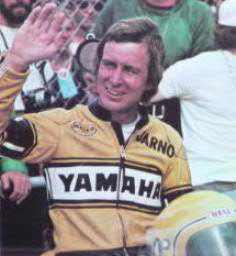
Jarno Karl Keimo Saarinen was a Finnish professional Motorcycle racer. He competed in the FIM Grand Prix motorcycle racing world championships from 1968 to 1971 as Yamaha privateer, before receiving the Yamaha factory's full support in 1972 and 1973. In the early 1970s, he was considered one of the most promising and talented motorcycle road racers of his era until he was killed during the 1973 Nations Grand Prix in Italy. Saarinen's death led to increased demands for better safety conditions for motorcycle racers competing in the world championships. He remains the only Finn to have won a solo motorcycle road racing world championship. Saarinen was inducted into the F.I.M. MotoGP Hall of Fame in 2009.

Phillip William Read, was an English professional motorcycle racer. He competed in Grand Prix motorcycle racing from 1961 to 1976. Read is notable for being the first competitor to win world championships in the 125 cc, 250 cc and 500 cc classes. Although he was often overshadowed by his contemporary, Mike Hailwood, he won seven FIM Grand Prix road racing world championships.

Kent Andersson was a Swedish professional motorcycle road racer. He competed in Grand Prix motorcycle racing between 1966 and 1975, most prominently as a member of the Yamaha factory racing team where he was a two-time 125cc World Champion. Andersson was notable for being the only Swedish rider to win an FIM road racing world championship.
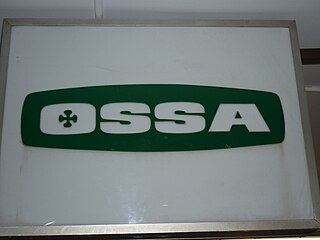
Ossa was a Spanish motorcycle manufacturer which was active from 1924 to 1982 and from 2010 to 2015. Founded by Manuel Giró, an industrialist from Barcelona, Ossa was best known for lightweight, two-stroke-engined bikes used in observed trials, motocross and enduro. The company was known originally as Orpheo Sincronic Sociedad Anónima (O.S.S.A.) and was later renamed Maquinaria Cinematográfica, S.A..
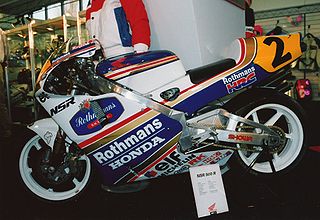
The Honda NSR500 is a road racing motorcycle created by HRC and debuted in 1984 for the Grand Prix motorcycle racing's 500 cc class. Honda won ten 500cc World Championships with the NSR500 from 1984 to 2002, with six in a row from 1994 to 1999. With more than 100 wins to its credit, the NSR500 is the most dominant force in modern Grand Prix motorcycle racing. The 1989 NSR500 that won Honda's third 500 World Championship with Eddie Lawson exemplifies the overwhelming power, acceleration and raw speed that has always been synonymous with Honda's 500 cc two-stroke V4.
The 1972 Grand Prix motorcycle racing season was the 24th F.I.M. Road Racing World Championship Grand Prix season. The season consisted of twelve Grand Prix races in six classes: 500cc, 350cc, 250cc, 125cc, 50cc and Sidecars 500cc. It began on 30 April, with West German Grand Prix and ended with Spanish Grand Prix on 23 September.
The 1969 Grand Prix motorcycle racing season was the 21st F.I.M. Road Racing World Championship Grand Prix season. The season consisted of twelve Grand Prix races in six classes: 500cc, 350cc, 250cc, 125cc, 50cc and Sidecars 500cc. It began on 4 May, with Spanish Grand Prix and ended with Yugoslavian Grand Prix on 14 September.
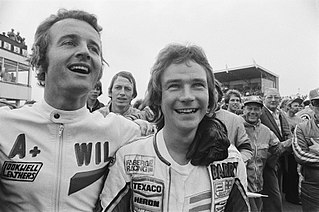
The 1977 Grand Prix motorcycle racing season was the 29th F.I.M. Road Racing World Championship season.

The 1980 Grand Prix motorcycle racing season was the 32nd F.I.M. Road Racing World Championship season.

The 1971 Grand Prix motorcycle racing season was the 23rd F.I.M. Road Racing World Championship Grand Prix season. The season consisted of twelve Grand Prix races in six classes: 500cc, 350cc, 250cc, 125cc, 50cc and Sidecars 500cc. It began on 9 May, with Austrian Grand Prix and ended with Spanish Grand Prix on 26 September.

The 1970 Grand Prix motorcycle racing season was the 22nd F.I.M. Road Racing World Championship Grand Prix season. The season consisted of twelve Grand Prix races in six classes: 500cc, 350cc, 250cc, 125cc, 50cc and Sidecars 500cc. It began on 3 May, with West German Grand Prix and ended with Spanish Grand Prix on 27 September.
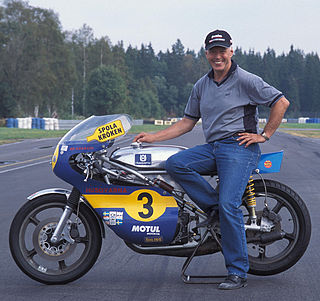
Bosse "Bo" Granath is a Swedish former Grand Prix motorcycle road racer. His most successful competitive year was 1972, when he finished fifth in the 500cc world championship riding a Husqvarna motorcycle.

John Cooper is an English former professional motorcycle racer and garage proprietor. He participated in British short-circuit motorcycle road racing during the 1960s and early 1970s. He also entered selected world championship Grands Prix motorcycle races. Cooper's motorcycle racing career extended over almost 20 years, mostly as a privateer rider, before experiencing his greatest achievements during the final three years of his career, most prominently at the 1971 Mallory Park Race of the Year, when he defeated the reigning 500cc world champion, Giacomo Agostini for a surprising upset victory.

The MV Agusta 500cc Three (1965–1973) or MV Agusta Tre was a road racing motorcycle produced by the Italian manufacturer MV Agusta to compete in the 500 cc Grand Prix motorcycle racing World Championship. The motorcycle was introduced in 1966 to compete against the ever competitive Honda racing machines and was a bored out version of MV Agusta's highly successful 350 cc three cylinder. Giacomo Agostini won consecutive world championships in the 500 cc class with this motorbike from 1966 to 1972. In addition, MV Agusta won the Constructors' World Championships from 1967 to 1972. The MV Agusta Tre is considered the most successful racing motorcycle in history.
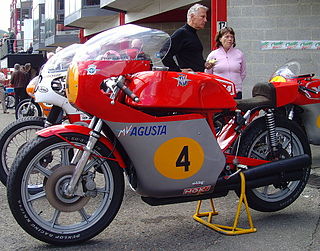
The MV Agusta 500cc road racers were motorcycles that the manufacturer MV Agusta built and which were used to compete in 500cc Grand Prix motorcycle racing series between 1950 and 1976. 18 500cc world championship titles were achieved with these machines ridden by John Surtees, Gary Hocking, Mike Hailwood, Giacomo Agostini and Phil Read between 1958 and 1974.

The Yamaha TZ 250 was a commercially available racing motorcycle with a watercooled, two-stroke, 250 cc engine produced by the Japanese manufacturer Yamaha.


















